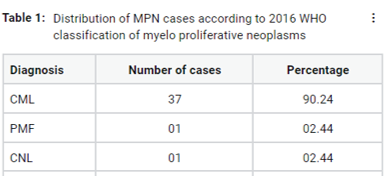Abstract
Myeloproliferative neoplasms (MPNs) are a group of disorders of hematopoietic stem cells which were initially recognised by William Dameshek in 1951. Objectives of the study were to diagnose and classify cases of myeloproliferative neoplasms according to 2016 revision of WHO classification of myeloid neoplasms and acute leukaemias, to study various haematological parameters of cases of MPNs (Peripheral smear findings, bone marrow aspirate and trephine biopsy) and their clinical manifestations, to record the cytogenetic/molecular genetic abnormalities of the cases and to categorise CML patients according to Hasford Risk Score as a predictor of prognosis. This study was a prospective study carried out in the Department of Pathology of a tertiary care hospital over two years from June 2016 to September 2018. The study included a total of 41 cases of MPNs. The cases of CMLs were diagnosed on peripheral blood findings, Bone marrow aspiration, Trephine biopsy Serum LDH and uric acid. CML was the most common MPN encountered (37/41; 90.24%) in the present study. Maximum serum LDH elevation was observed in CML cases with a mean value of 1396.6 U/L. Of the 37 CML cases, as per Hasford score, 17 cases were categorised into a low-risk group, 17 cases into an intermediate-risk group and 3 cases into a high-risk group. In the present study of Hasford score in CML cases, it was found that it helps in making a better-informed decision about the adaption of alternative high-risk treatment, and was of value in oncology practice.
Full text article
Authors

This work is licensed under a Creative Commons Attribution-NonCommercial-NoDerivatives 4.0 International License.

